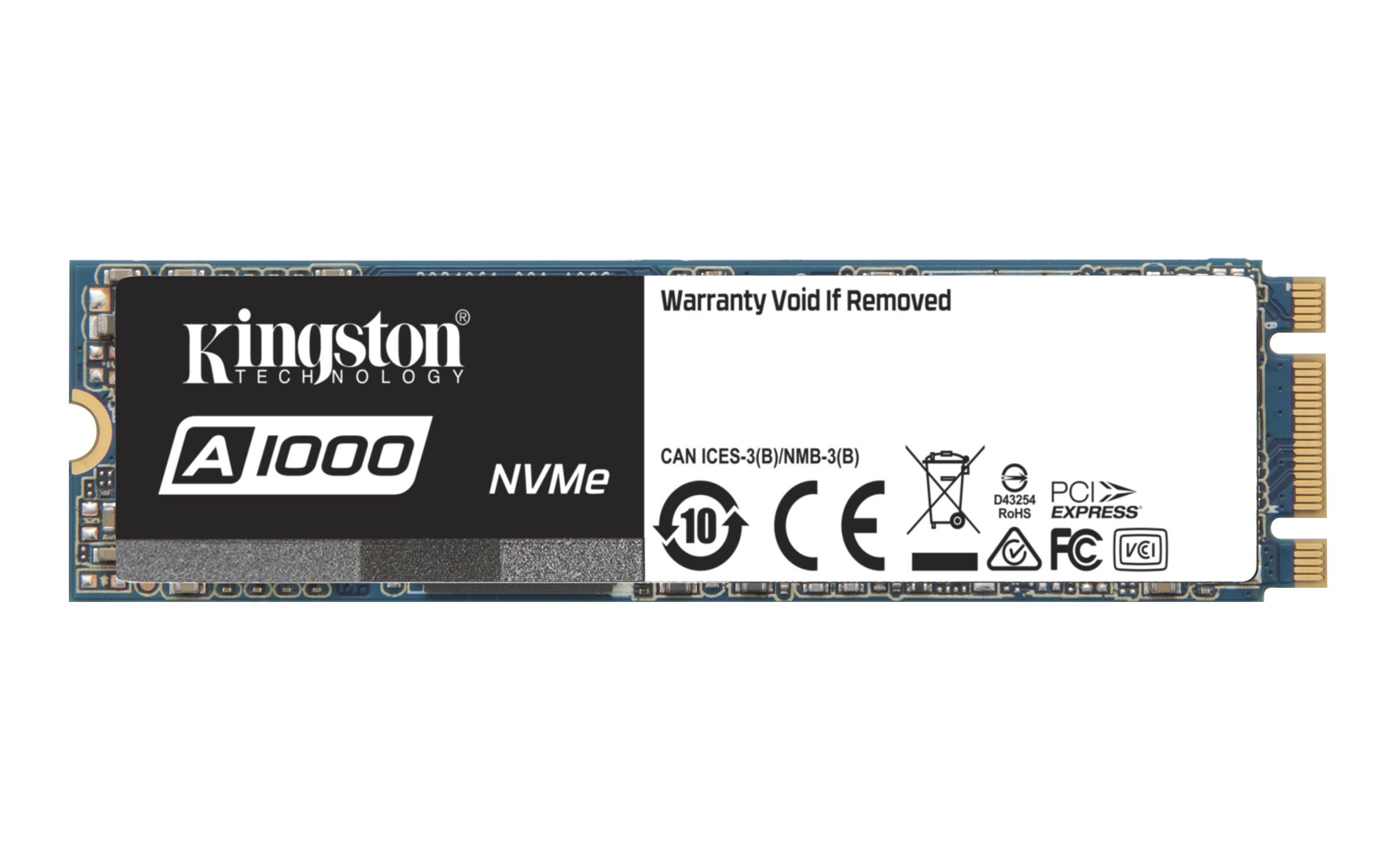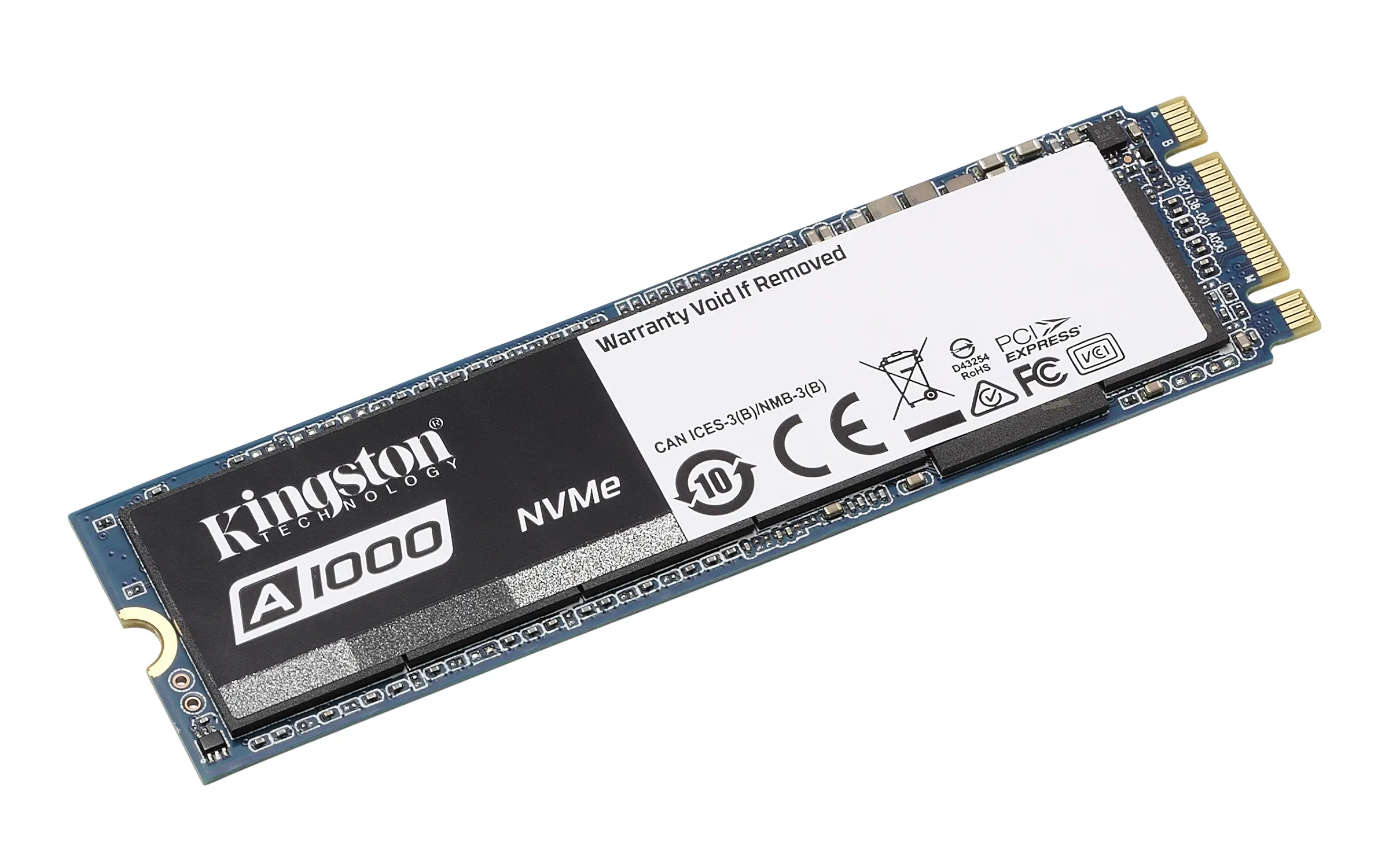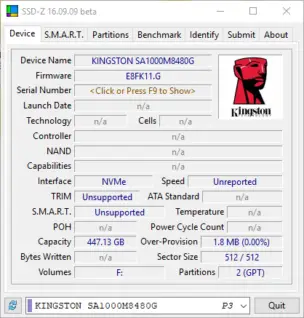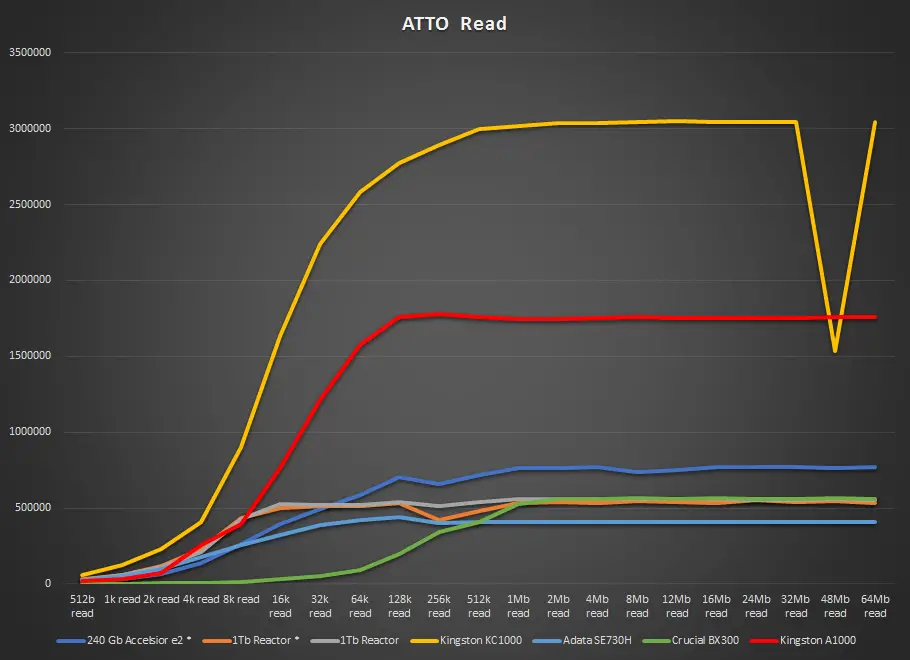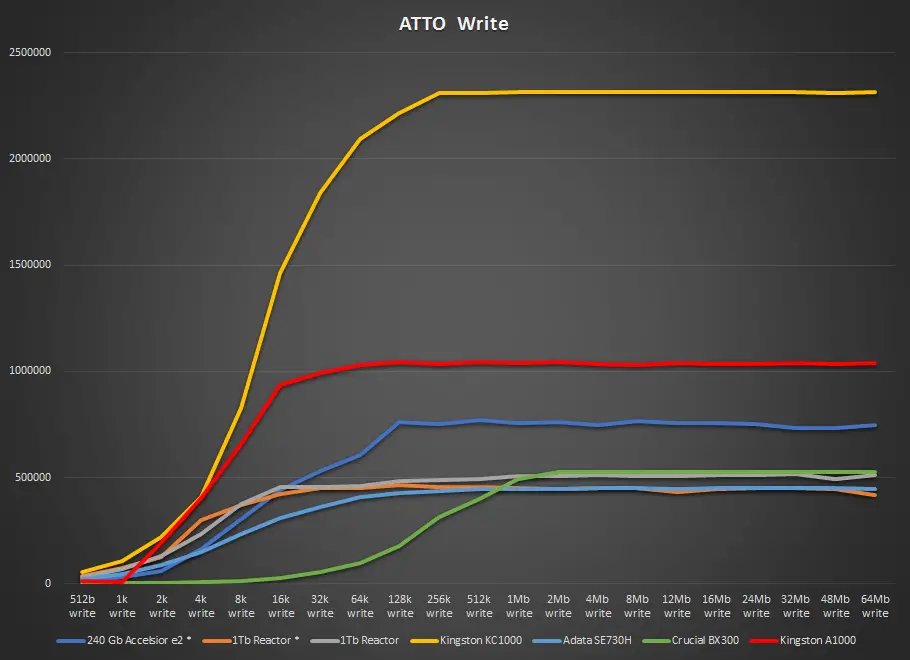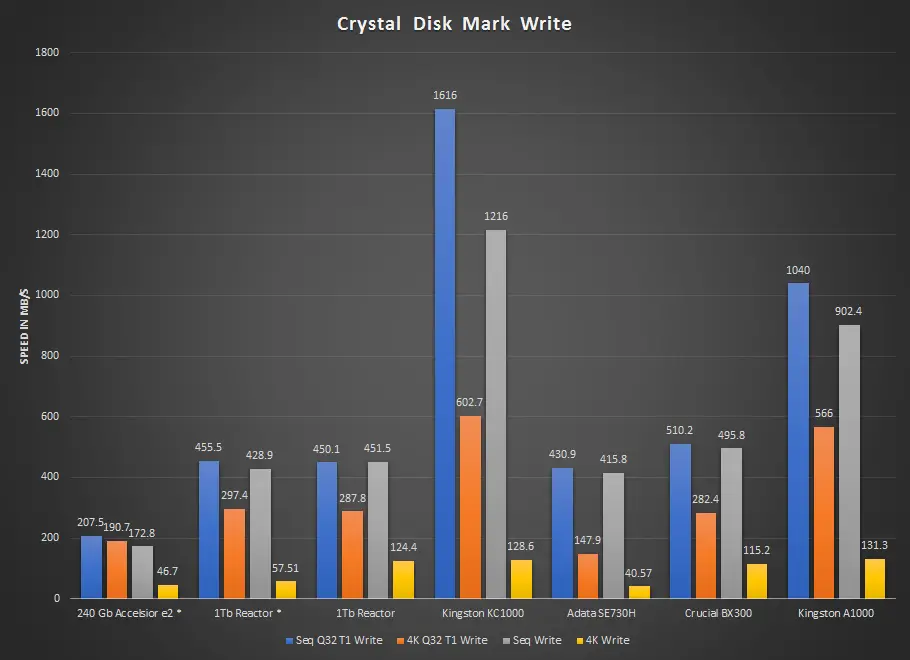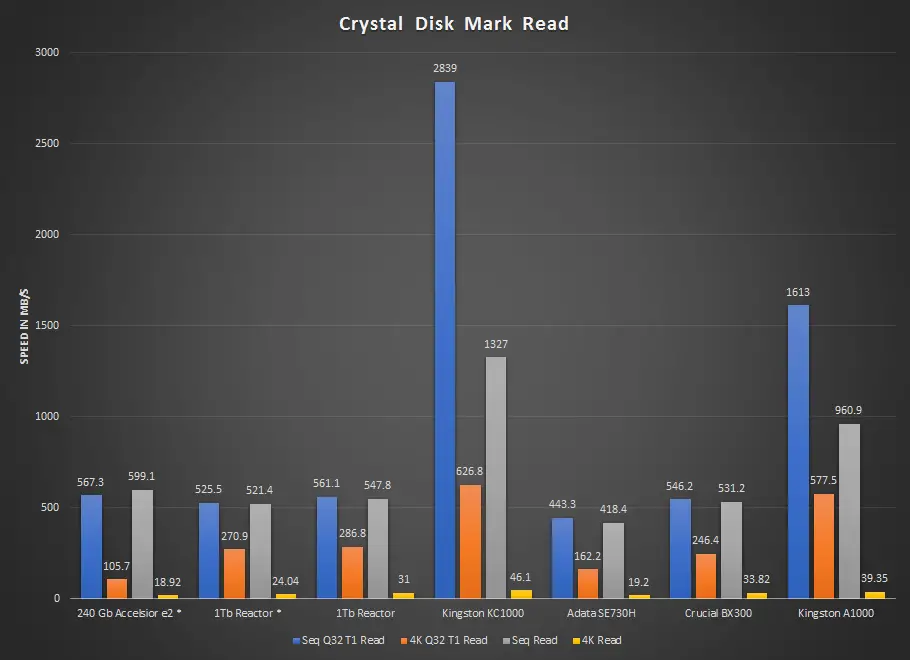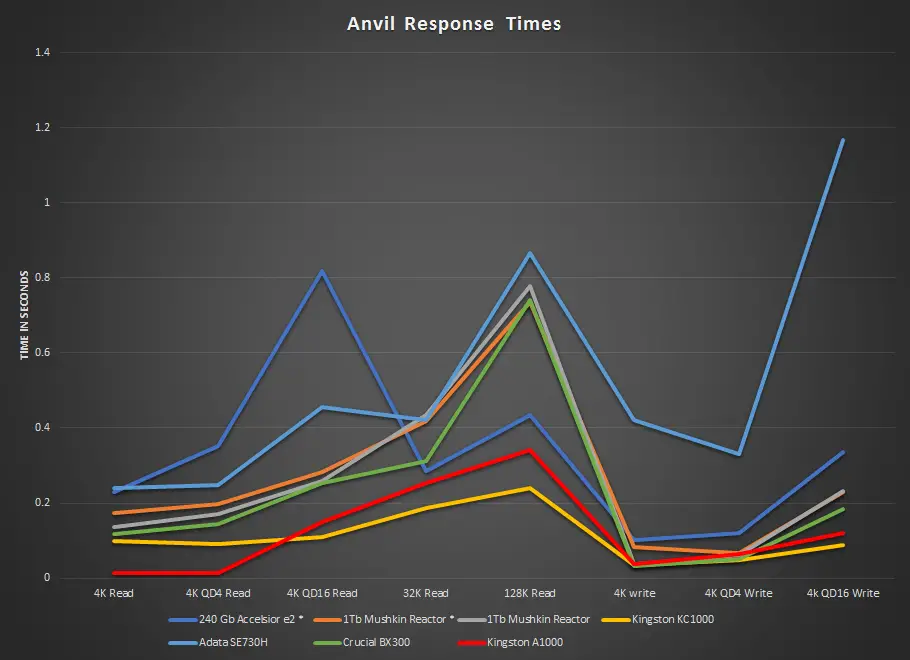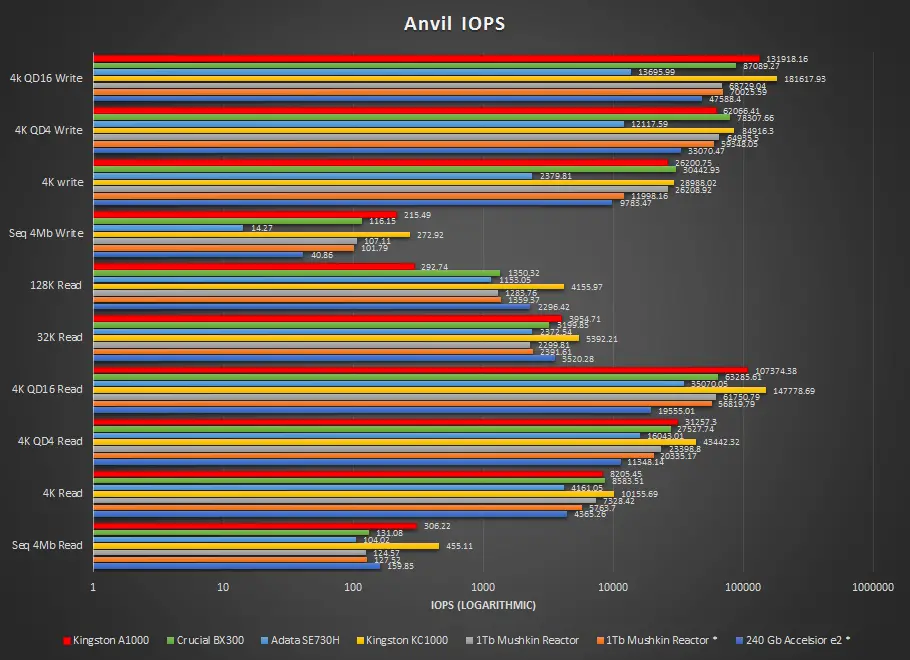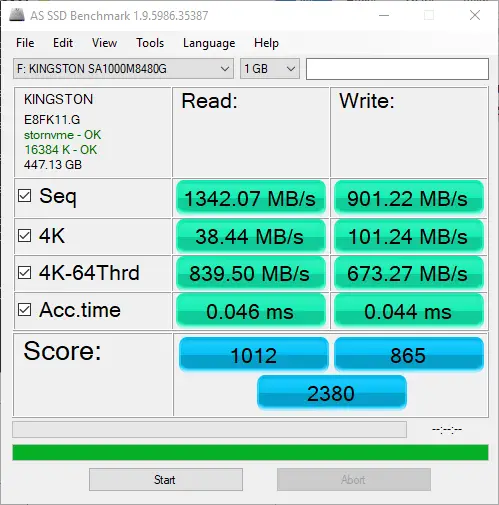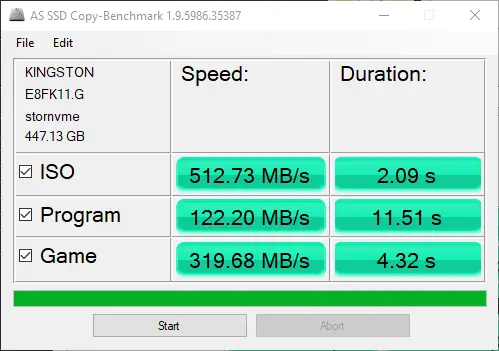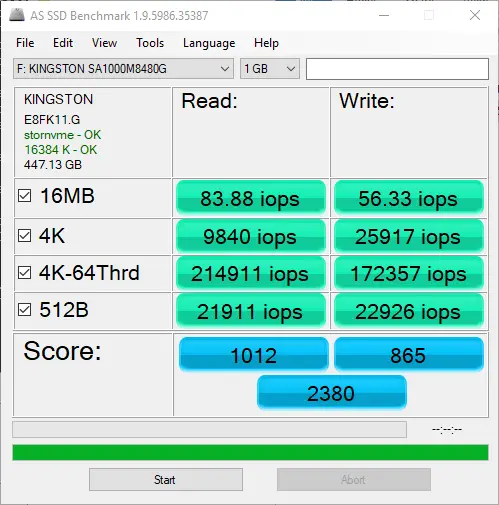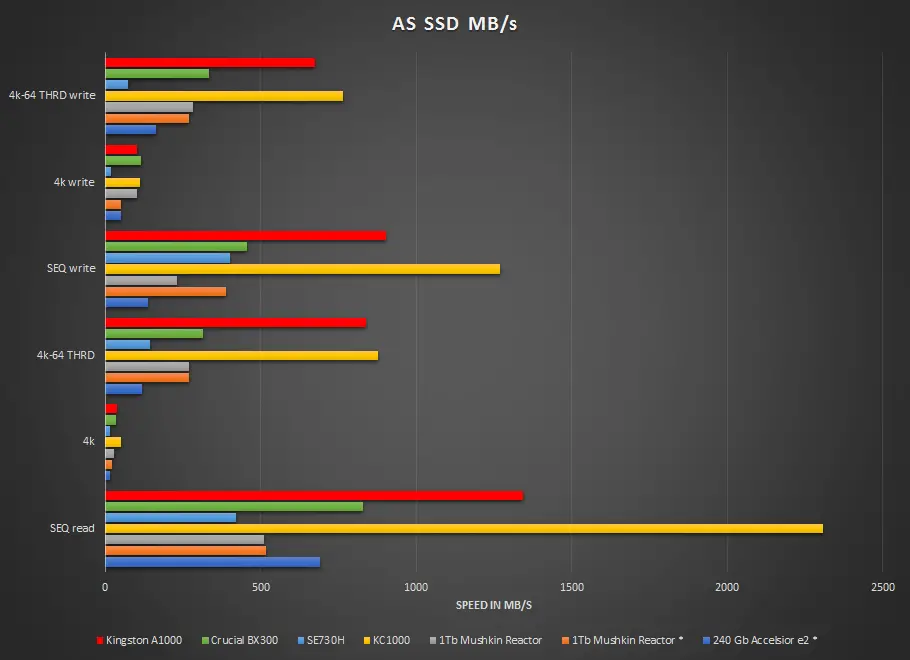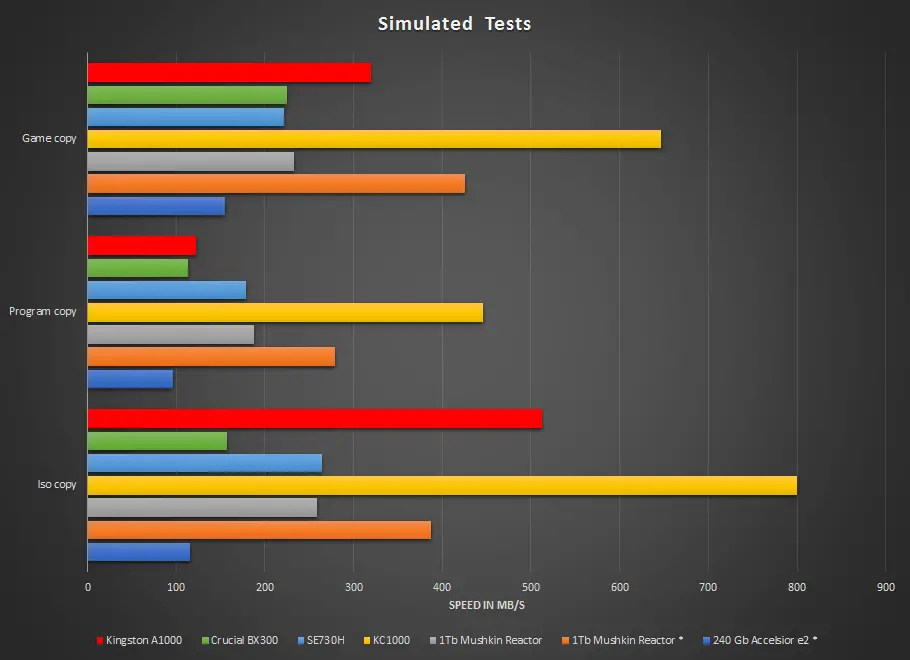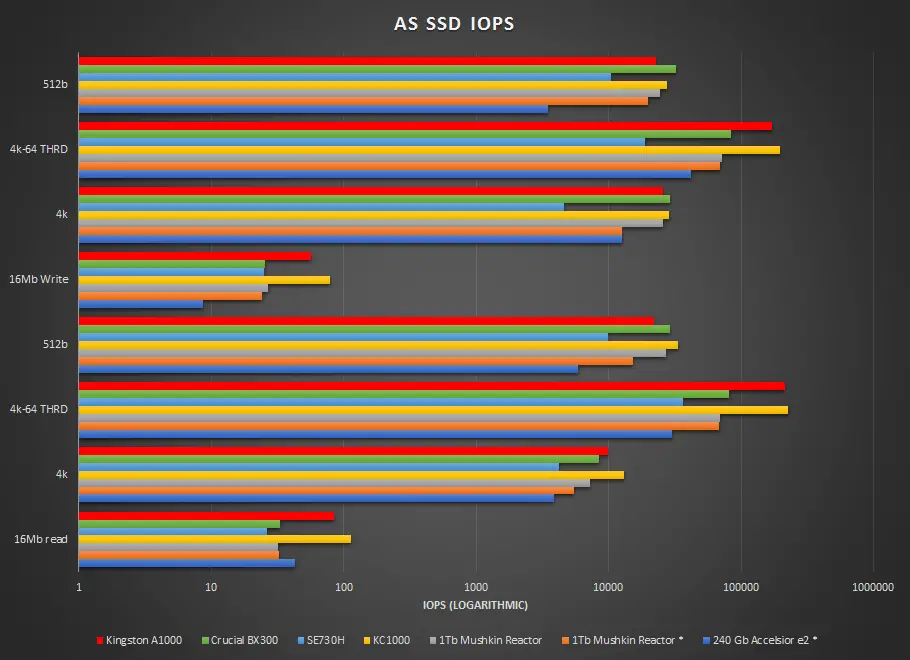Kingston A1000 NVME SSD Review
Our first look at NVME left us hungry for more even if we were hesitant of the pricepoint. Kingston saw fit to follow up on their KC1000 with a drive that offered the same capacity in a less wallet emptying form with the A1000.
Our Test system and Procedure
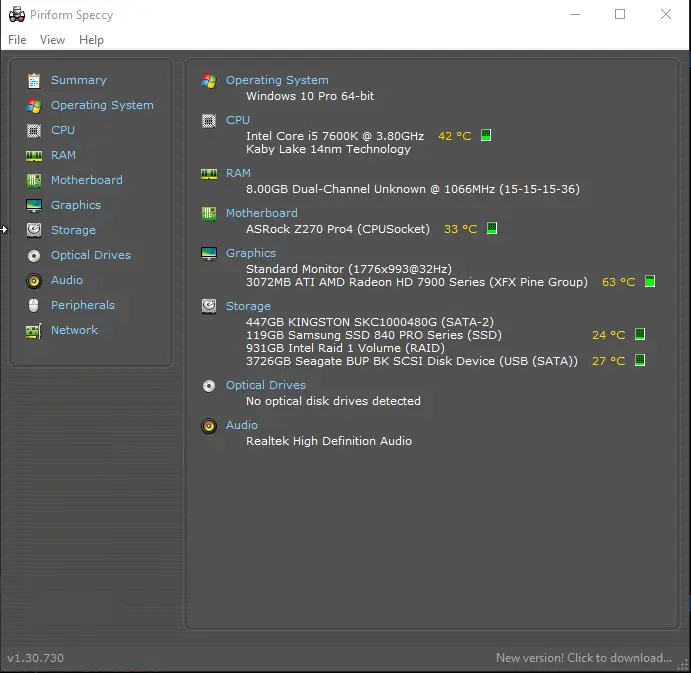
We detailed our new test system in it’s own article. For testing the A1000 was placed in the furthest m.2 slot to prevent thermal influence from other components. The system is running windows 10 Professional and was under no load(AV disabled) for all tests. Testing will consist our standard set of tests which we outlined previously. We’re going to include two drives from our previous test bench
The A1000 And accessories
Unlike it’s higher end sibling the review sample for the A1000 we were sent was rather barebones. No pcie to m.2 adapter is included which on a budget drive is an acceptable choice. The drive itself is a single sided design allowing for mounting in the thinnest of systems.
| Capacity | 240GB | 480GB | 960Gb |
|---|---|---|---|
| Controller | PS5008-E8 | PS5008-E8 | PS5008-E8 |
| Firmware | E8FK11.G | ||
| NAND | Toshiba 64nm BiCS TLC | Toshiba 64nm BiCS TLC | Toshiba 64nm BiCS TLC |
| Interface | NVMe PCIe 3.0x2 | NVMe PCIe 3.0x2 | NVMe PCIe 3.0x2 |
| Sequential Read | 1500 MB/s | 1500 MB/s | 1500 MB/s |
| Sequential Write | 800 MB/s | 900 MB/s | 1000 MB/s |
| Maximum 4k Random Read | 100,000 IOPS | 100,000 IOPS | 120,000 IOPS |
| Maximum 4k Random Write | 80,000 IOPS | 90,000 IOPS | 10,000 IOPS |
| Temperature range | 0-70°C | 0-70°C | 0-70°C |
| Form Factor | M.2 2280 | M.2 2280 | M.2 2280 |
| Dimensions | 80mmx22mmx3.5mm | 80mmx22mmx3.5mm | 80mmx22mmx3.5mm |
| Endurance | 150TBW .342 DWPD | 300TBW .342 DWPD | 600TBW .342 DWPD |
| Warranty | 5 years | 5 years | 5 years |
Looking at the numbers the A1000 takes a hit in performance with figured at just above half of what it’s higher end sibling is rated for. Without diving too deeply into controller architecture the key reason for this is likely the move to a PCIe 3.0 2x interface. This will still allow much faster than SATA performance even if it can’t compete with higher end NVME devices.
What is NVME
NVME stands for non volatile memory express. It replaces the old AHCI(Advanced host controller interface) that was used for SATA devices. The largest advantages NVMe has over AHCI are a substantial decrease in cpu overhead and a connection to a much higher bandwidth PCIe bus. None of the legacy commands for using spinning media are present either. NVMe was built for speed from the ground up.
What happened to TRIM
TRIM was an extension to the AHCI command set introduced to improve the performance of solid state drives. Since NVMe was built specifically with SSD’s in mind it already has similar features in the command set. As such NVMe SSD’s won’t show support for the old AHCI trim command.
SSD-Z
As before unfortunately SSD-Z continues to struggle with NVMe devices. We do see the total capacity, 447GB out of the designed 480GB which is t be expected.
ATTO 3.05
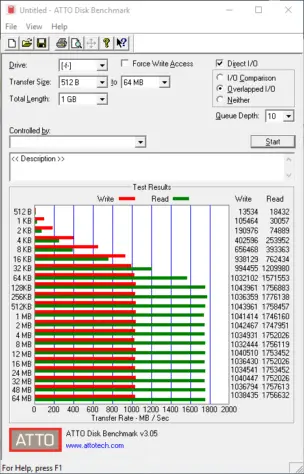 Atto shows writes hitting a cap at just over 1GB/s at a 64KB block size. Reads however continue to climb until a transfer size of 128KB is reached Unlike with other NVMe drives we’ve seen there isn’t a drop anywhere due to an overheat. As M.2 devices have matured there have been a few developments in thermal management. When combined with a more mainstream performance target helps keep heat under control.
Atto shows writes hitting a cap at just over 1GB/s at a 64KB block size. Reads however continue to climb until a transfer size of 128KB is reached Unlike with other NVMe drives we’ve seen there isn’t a drop anywhere due to an overheat. As M.2 devices have matured there have been a few developments in thermal management. When combined with a more mainstream performance target helps keep heat under control.
The KC1000 is still the fastest drive we’ve looked at but that doesn’t stop the A1000 from soundly outperforming the SATA drives we’ve looked at. With solid read and write performance anyone moving from SATA to NVMe won’t be disappointed here although price will be the ultimate decision there.
Crystal Disk Mark 5.1.2 x64
 Crystal Disk Mark shows us our first glimpse of random data. Random data is an interesting spot as it’s not all that different from what we saw on the higher end model. Considering that the controllers are related with results not being held back by the PCIe 2x interface similar performance isn’t surprising.
Crystal Disk Mark shows us our first glimpse of random data. Random data is an interesting spot as it’s not all that different from what we saw on the higher end model. Considering that the controllers are related with results not being held back by the PCIe 2x interface similar performance isn’t surprising.
The KC1000 may be the record holder here but the A1000 still has read and write performance above the rest of the pack. Sata drives struggle to reach sequentially what NVMe enables as random performance. Even for a budget drive the performance is impressive.
Anvil
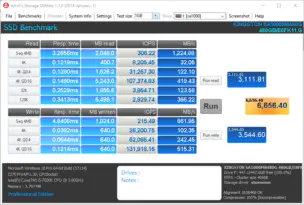 Anvil gives us a good look at some response times as well as validating earlier tests. Response time is really what we feel it’s the delay between a request for data and actually receiving it. All solid state drives offer impressive response times compared to spinning media however. Compared to Sata drives NVMe devices have a lower overhead and drive this to absurdly low levels and the A1000 is no exception.
Anvil gives us a good look at some response times as well as validating earlier tests. Response time is really what we feel it’s the delay between a request for data and actually receiving it. All solid state drives offer impressive response times compared to spinning media however. Compared to Sata drives NVMe devices have a lower overhead and drive this to absurdly low levels and the A1000 is no exception.
Starting with response times we’re in for a bit of a surprise. The A1000 actually outperforms it’s older sibling here by a significant margin in the low queue depth tests. Performance at QD1 through QD4 is typical for most consumer and even workstation applications so unless you were putting it in a database server the lower end drive will actually feel more responsive, that is if you can tell the difference between 0.01219 and 0.0985 seconds. Higher depths do highlight the benefits of a more powerful controller and wider interface however. Looking at IOPS and MB/s results we see the same trend we’ve been seeing where the A1000 outperforms all of the sata drives but can only meet the random performance of the KC1000 while sequential tests firmly belong to the other drive.
AS SSD
As always we see a bit of a drop in our sanity check AS SSD. We’re not seeing any suprises here which is a good thing we also have the handy built in real world simulated tests. The simulated tests however seem to highlight a particular weakness in the program section but we’ll reserve judgement just yet.
The simulated tests are somewhat surprising showing that the mixed workload of a program copy puts the A1000 back with the SATA drives as opposed to in line with the KC1000. Everything else however keeps is exactly where it has been the rest of the time, faster than SATA by a comfortable margin.
Consistency Test
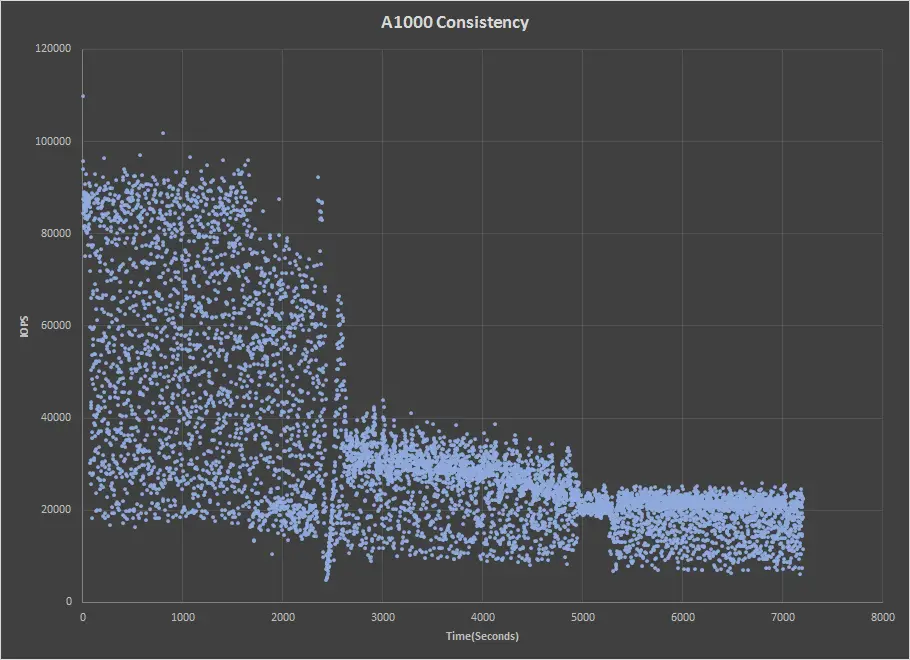 Consistency isn’t nearly as tight as we’re used to seeing at first however with just shy of a 20k minimum over the first 15 minutes the drive isn’t off to a terrible start. As we close out the final 5 minutes we see a ~10k iop floor and a ~25k iop ceiling, it’ll be the comparison with the other drives that tells the rest of that story.
Consistency isn’t nearly as tight as we’re used to seeing at first however with just shy of a 20k minimum over the first 15 minutes the drive isn’t off to a terrible start. As we close out the final 5 minutes we see a ~10k iop floor and a ~25k iop ceiling, it’ll be the comparison with the other drives that tells the rest of that story.
 We used to call the reactors consistency good for a consumer drive however this is our second drive in the 3+ territory for this particular metric. Beating out it’s older sibling likely thanks to more refined firmware the A1000 takes the top spot in the consistency chart.
We used to call the reactors consistency good for a consumer drive however this is our second drive in the 3+ territory for this particular metric. Beating out it’s older sibling likely thanks to more refined firmware the A1000 takes the top spot in the consistency chart.
Pricing
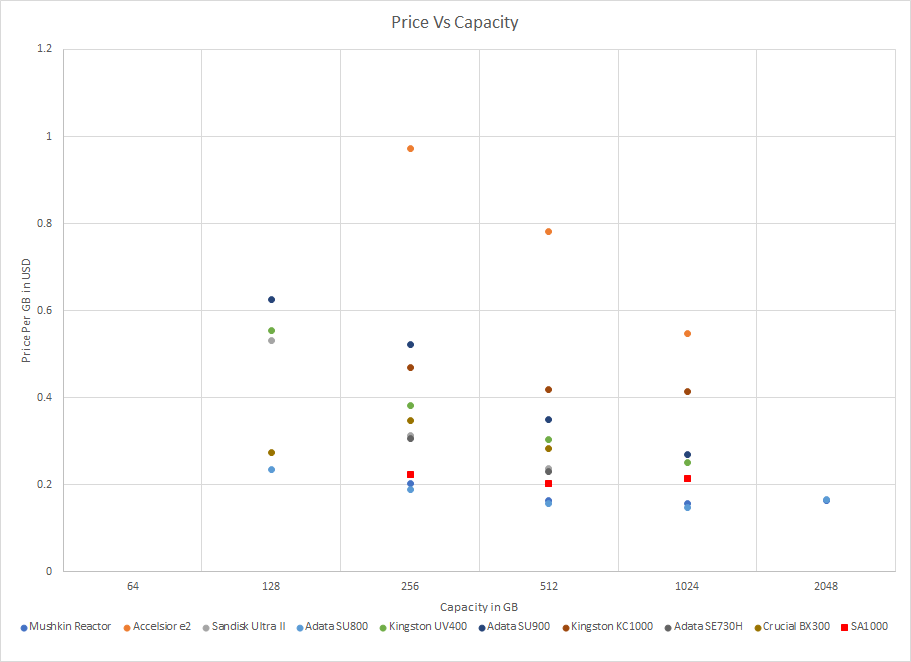 Pricing on the A1000 is a bit of a shock. Per Gb it’s just a little bit above the usual performance per dollar winner the Mushkin Reactor. And at a price of just over .2 per gb in most cases for anyone who has an NVMe capable device and wants more than SATA can offer without going overboard it’s going to be a winner.
Pricing on the A1000 is a bit of a shock. Per Gb it’s just a little bit above the usual performance per dollar winner the Mushkin Reactor. And at a price of just over .2 per gb in most cases for anyone who has an NVMe capable device and wants more than SATA can offer without going overboard it’s going to be a winner.
Closing Thoughts
Offering equal to or just over half the performance of a higher end drive for a price that’s hovering at half the cost is a very tempting value proposal for those who might be on the fence for NVMe. With prices of 54.99 and 99.99 for the 240 and 480gb models respectivly the A1000 should be an easy sell. At 219.99 for the 960 however it might be tempting to take a performance hit and shell out just a little more for a roomier 2TB drive. With that said the A1000 is offering excellent performance at a very competitive price even if there isn’t an included HHHL adapter.

